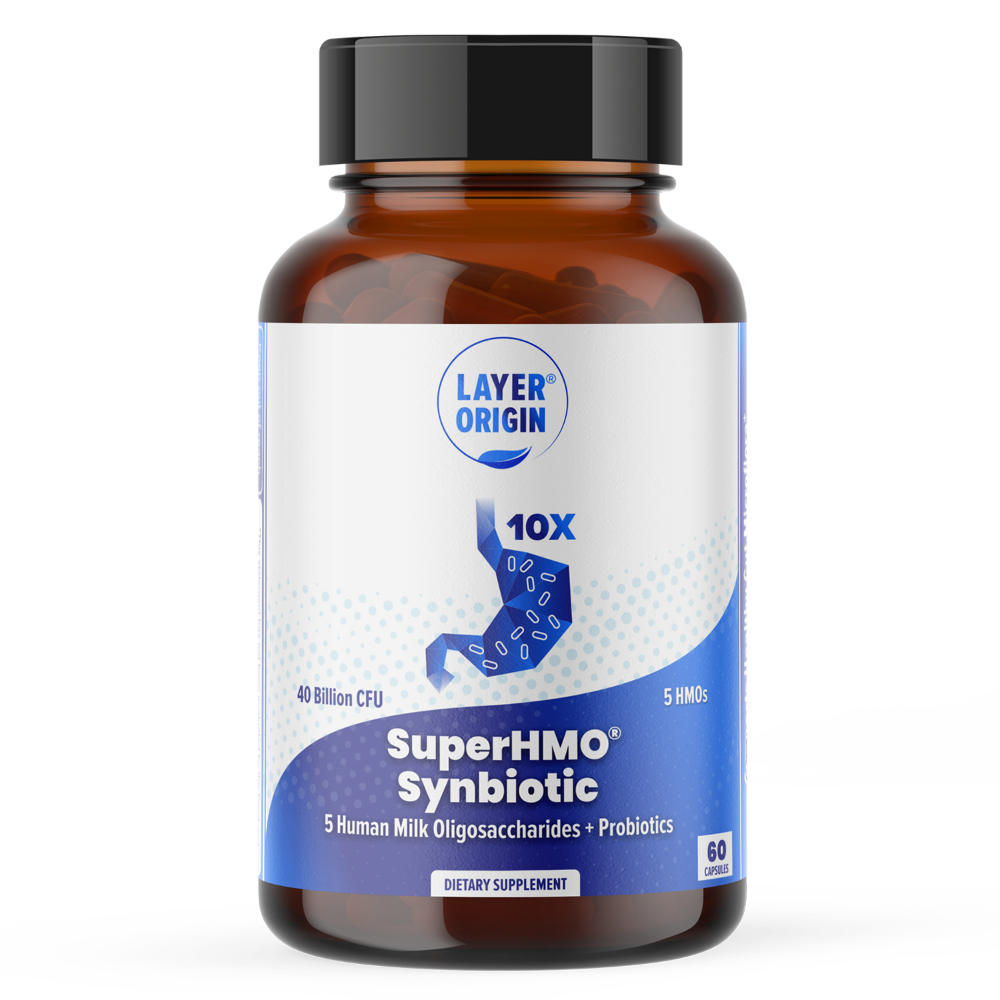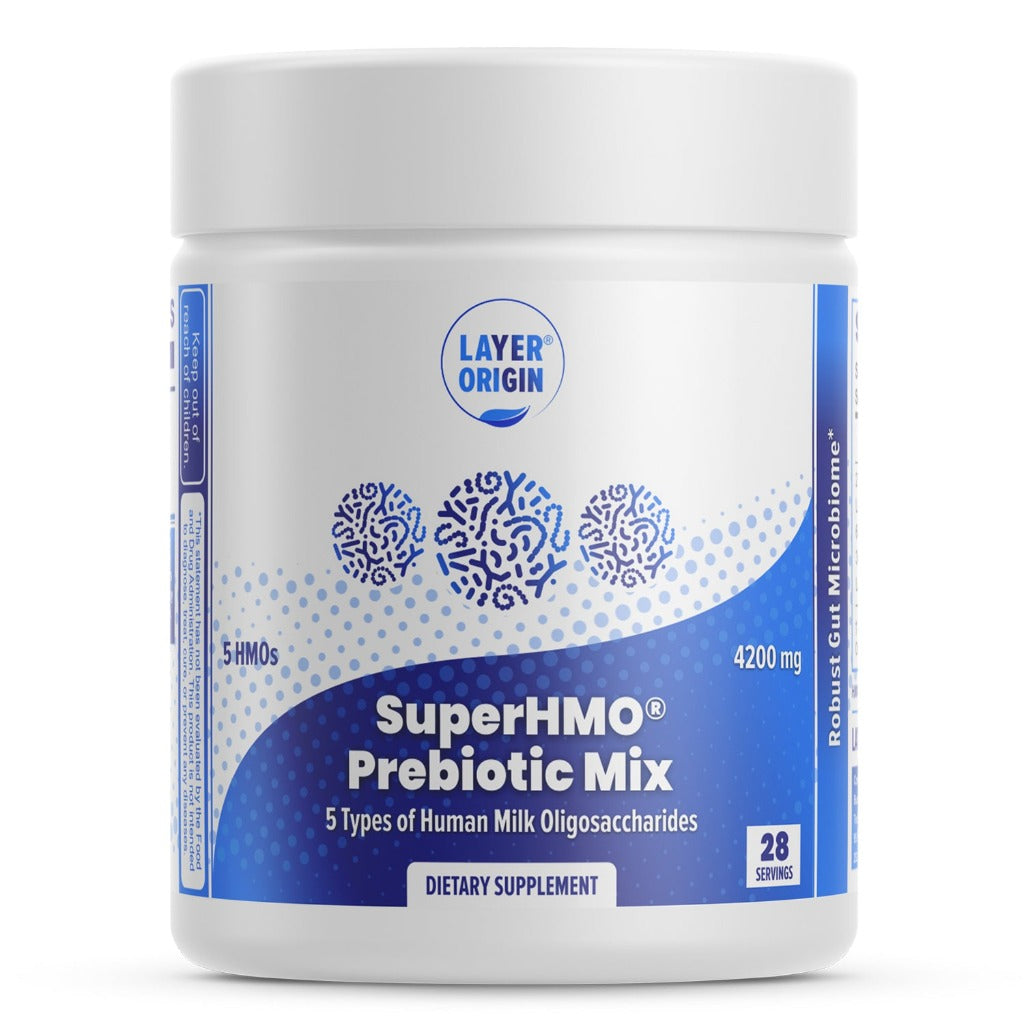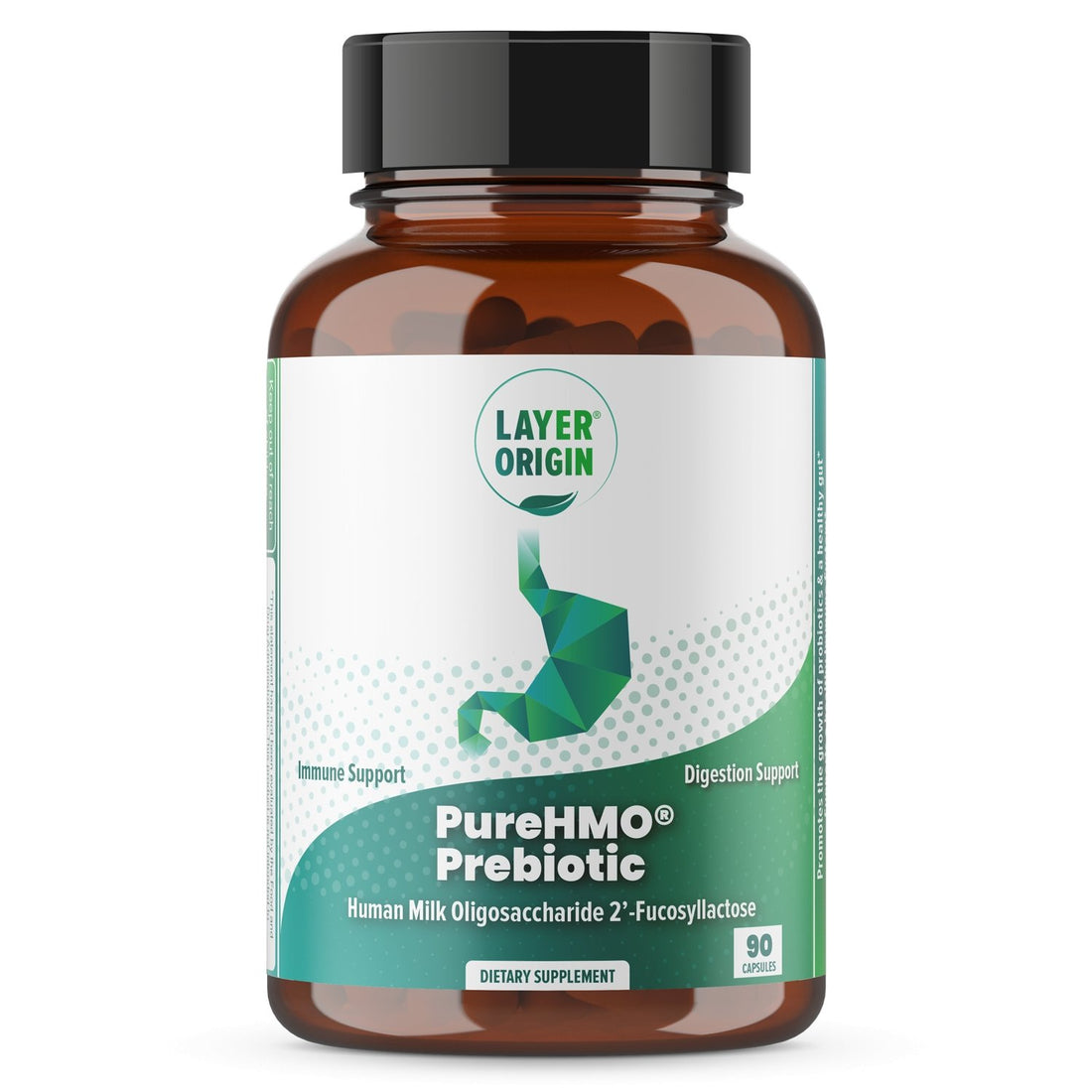Article Outline
- Introduction
- Background on HMOs
- What are the effects of low doses of HMOs on the gut microbiome?
-
What were the results?
- Summary of the main findings
- Age-dependent differences in gut microbiome composition
- From low doses onwards HMOs impact key fermentation parameters
- HMOs increased bacterial cell density and maintained high diversity
- Low doses of HMOs exert strong Bifidobacteriaceae effects
- HMOs influence a range of health-associated metabolites even at low doses
- Summary
Introduction
Human milk oligosaccharides (HMOs) have been the subject of many scientific research studies in recent years. Until now. Researchers from Switzerland and Belgium examined how dose impacts the gut microbiomes of 6-year-old children and adults, and the results are promising.
Background on HMOs
The gut microbiome plays an integral role in human health, supporting many of the body’s systems, including the digestive, immune, and nervous systems. However, just like you and I, this unique ecosystem needs sustenance to survive and thrive. Much of the human diet provides the nutrients needed to feed the trillions of inhabitants in the gut, including fruit, vegetables, whole grains, and legumes, which function as prebiotics.
Prebiotics are fibers that promote the growth and activity of gut microbes. One emerging prebiotic is human milk oligosaccharides. HMOs are the third most abundant component of human breast milk. They have many health benefits for both the developing and developed gut, including:
- promoting microbial diversity
- preventing pathogen adhesion
- protecting against viruses
- immune system development and strengthening[1]
What are the effects of the dosage of HMOs on the gut microbiome?
Elison et al. (2016) investigated the effects of 2’-fucosyllactose (2’FL) and or Lacto-N-neotetraose (LNnT) over 2 weeks in healthy adults. Their research found that daily doses of up to 20 g a day were well-tolerated and increased the abundance and activity of Bifidobacteria.
Palsson and colleagues (2020) found that a daily 5 g supplement of 2’-FL and LNnT could normalize bowel habits in IBS patients, improving symptoms and quality of life[2]. While Iribarren et al (2020) also found a 2’-FL and LNnT mix for 4 weeks increased the abundance of Bifidobacteria without worsening IBS symptoms[3].
However, Bajic et al. (2024) thought that lower doses at 0.3 g/day, could be effective for modulating the gut microbiomes of both adults and children[4]. The study was conducted after the same team had assessed the impact of a mix of 4 HMOs at a dose of 0.3-5 g/day compared to more traditional prebiotics, inulin, and fructooligosaccharides (FOS). HMOs were shown to be promising modulators of both adult and child microbiomes. The 4 HMOs used in the previous study were:
- 2’-Fucosyllactose (2’-FL)
- Lacto-N-neotetraose (LNnT)
- 3’Sialyllactose
- 6’Sialyllactose
Interestingly, the study highlighted some age-dependent differences, such as an increase in melatonin in children by 2’FL and LNnT and an increase in folic acid in adults by 3’SL.
The current study aimed to assess the impact of these 4 HMOs at doses of 0.3 to 5 g/day on the composition of the microbiome and metabolite production in adults and children.
How did the researchers conduct their study?
The researchers analyzed the same four HMOs as they did in their previous study (2’FL, LNnT, 3’SL, and 6’SL) at human equivalent doses of between 0.3 and 5g/day. SIFR® technology combined with an up-to-date multi-omics approach was used to evaluate the effects of the doses.

Figure 1. The researchers collected fresh fecal samples from 6 donors per age group. The selection criteria for adults included no antibiotic use in the previous 3 months, no probiotic use, no gastrointestinal disorders, no smoking, alcohol consumption that did not exceed 3 units per day, and a body mass index between 20 and 25. SIFR® technology assessed the impact of the four single HMOs at low doses on the gut microbiota of 6-year-old children and adults compared to a no-substrate control.
What were the results?
The study showed that overall, the HMOs increased the production of short-chain fatty acids (SCFAs) in both adults and children, and that the strength of the effects increased with increasing doses. Here, we’ll take a closer look at some of the findings.
Summary of the main findings
- All HMOs significantly increased the production of SCFAs between doses of 0.3 and 5 g/day
- All doses of every HMO increased acetate and propionate in adults and children
- Each dose of each HMO, except the lowest doses of the two sialylated HMOs, increased butyrate production in adults
- LNnT specifically increased butyrate
- 6’SL had a significant impact on the production of propionate in adults
- All HMOs increased Bifidobacteriaceae in children
- 2’FL and LNnT increased Bifidobacteriaceae in adults
- Increase in Bifidobacteria increased acetate production
- The beneficial effects of HMO administration goes beyond just SCFA; they also increase the production of other health-related metabolites
Age-dependent differences in gut microbiome composition
One of the first observations from the study was the difference in the composition of the fecal microbiota between adults and children. One of the key differentiators is the Bifidobacteriaceae family. The researchers noted that:
- The children’s microbiota was enriched with catenulatum and B. pseudocatenulatum
- adolescentis was an abundant bacterium in the adult microbiome
The observations mirror previous in vivo studies. For example, Derrien et al (2022) stated that the abundance of Bifidobacterium in the healthy adult microbiome is more than 90% with B. longum and B. adolescentis being the most abundant species[5].

Figure 2. The abundance of Bifidobacteria species in the human adult microbiome. B. longum and B. adolescentis are the most abundant species.
Find out more about the effect of aging on the composition and diversity of the human gut microbiome here.
From low doses onwards, HMOs impact key fermentation parameters
Across both adult and child microbiomes, all four HMOs impacted key fermentation parameters at 24 hours in a dose-dependent manner. The following summarises the key findings:
- all 4 HMOs increased acetate, propionate and total SCFAs in adults and children
- all 4 HMOs significantly lowered the pH in adults and children
- 6’SL increased propionate production in adults given 5g/day
- All HMOs, particularly LNnT significantly increased butyrate production in adults except for 0.3 g/day of 3’SL and 0.5 – 1 g/day of 6’SL

Figure 3. In children, acetate and propionate increased from the lowest doses onwards with all 4 HMOs. In adults, butyrate production increased significantly with all HMOs except for the low doses of 3’SL and 6’SL. The results can be seen in the graph above; acetate (A&B), propionate (C&D), and butyrate (E&F).
An increased production of SCFAs is linked to better health outcomes. For example, an increase in butyrate was seen in both adults and children. Butyrate is the main energy source for colonocytes, the cells that line the gut, and has many important functions, particularly in gastrointestinal health. Therefore, identifying the HMOs that increase specific SCFA levels can be beneficial for future health applications[6].
HMOs increased bacterial cell density and maintained high diversity
Interestingly, the no-substrate control recorded an increase in bacterial cell density over the 24 hours. The diversity also remained high, which helped to confirm the effectiveness of the SIFR® technology.
Compared to the control, the highest dose of 5 g/day increased bacterial cell density with all HMOs. When considering the richness of species, diversity was similar for all HMOs and the control in adults, but there was a significant reduction in children at high doses of 2’FL and 3’SL. These results suggest that some species become very abundant.
Low doses of HMOs exert strong Bifidobacteriaceae effects
All four HMOs exerted bifidogenic effects in children with 2’FL and LNnT, having the same effect in adults. The effects of 2’FL, LNnT, 3’SL, and 6’SL on Bifidobacteriaceae and Bacteroidaceae are shown in the table below:
|
|
Children |
Adults |
||
|
|
Bifidobacteriaceae |
Bacteroidaceae |
Bifidobacteriaceae |
Bacteroidaceae |
|
2’FL |
↑ |
|
↑ |
|
|
LNnT |
↑ |
|
↑ |
|
|
3’SL |
↑ |
|
|
↑ |
|
6’SL |
↑ |
|
|
↑ |
The increase in Bacteroidaceae by the sialylated HMOs was suspected to increase the abundance of the succinate converter, Phascolarctobacterium faecium, which increased when 6’SL was administered to children.
However, this wasn’t the only evidence of cross-feeding in the study. Veillonellaceae, a member of the Firmicutes phylum, also had an increased abundance, particularly at the higher HMO doses and in children. This is likely to be because Veillonellaceae consumed the lactate produced by Bifidobacteriaceae.
Did you know? You can increase your intake of sialylated HMOs with the SuperHMO® Prebiotic Mix with 5 key HMOs, including the 4 used in this study and lacto-N-tetraose (LNT).
There were also dose-dependent and HMO-dependent increases in several other Firmicutes bacteria:
|
|
Children |
Adults |
||||||
|
|
2’FL |
LNnT |
3’SL |
6’SL |
2’FL |
LNnT |
3’SL |
6’SL |
|
Coprobacillaceae |
|
ü |
ü |
ü |
|
ü |
|
|
|
Lachnospiraceae |
|
|
|
|
ü |
ü |
ü |
ü |
|
Oscillospiraceae |
|
|
|
ü |
|
ü |
|
|
|
Ruminococcaceae |
|
|
|
ü |
ü |
ü |
ü |
ü |
The results also confirmed there were distinct differences in the bacteria between adults and children involved in HMO fermentation.
HMOs influence a range of health-associated metabolites even at low doses
Alongside the marked increases in SCFA production facilitated by HMOs, Bajic et al., also observed an increase in health-related metabolites. As the doses of the HMOs increased up to 5g/day, the effects on these metabolites became more potent.
The impact of the HMOs at low doses and beyond on health-related metabolites is shown in Figure 4.

Figure 4. Heat maps show how the 4 HMOs impact a range of metabolites at different doses.
Figure 4B highlights the 36 distinct metabolites affected by the HMOs 2’FL, LNnT, 3’SL, and 6’SL, spanning multiple metabolic pathways including amino acid metabolism, neurotransmission, nucleotide turnover, vitamin regulation, and microbial activity. These metabolites are not only important for the body’s day-to-day function, but their presence also shows how HMOs shape the gut microbiome and, in turn, host metabolism.
In adults, 2’FL and LNnT were the strongest modulators of the aromatic lactic acids, particularly indole-3-lactic acid, 3-phenyllactic acid, and 2-hydroxyisocaproic acid, especially at the higher 5g/day doses. These molecules are products of bacterial amino acid fermentation, acting as signalling agents, antioxidants, and protein turnover.
Furthermore, γ-aminobutyric acid (GABA), a calming neurotransmitter derived from glutamate, and phenethylamine, a neuroactive compound derived from phenylalanine, also slightly increased with HMO intake, highlighting the link between HMOs, mood, and cognition, via the gut-brain axis.
Other metabolites, such as acetylcholine, an important neurotransmitter, pentose (the sugar backbone of nucleotides), 3-aminioisobutyric acid, and phosphocholine (a key component of cell membranes), were all increased with all the HMOs at every dose, but more so with the higher doses. Increases in nucleobases and nucleosides, including adenine, cytosine, uracil, xanthine, adenosine, CMP, GMP, and UMP, as well as their methylated forms such as 5-methylcytosine and 7-methylguanine, which play crucial roles in DNA/RNA synthesis and energy transfer, also increase with HMO consumption.
Finally, all 4 B vitamins (biotin, nicotinic acid, pantothenic acid, and thiamine) increased with HMO consumption. Interestingly, pantothenic acid increased most with 3’SL and 6’SL, especially at the highest doses, while thiamine increased most with a 5g dose of 6’SL.
This study highlights the health-promoting potential of HMOs beyond just the stimulation of the production of short-chain fatty acids (SCFAs). Many of these metabolites have important roles in:
-
immunity
-
anti-inflammation
-
antioxidant potential
-
protection against chronic disease
Although many of these metabolites are not produced directly from HMOs, this indicates that HMOs can indirectly stimulate their production by enhancing the growth of specific bacterial species or changing the pH of the colonic environment.
Overall, HMOs are important microbiome modulators, encouraging the expansion of a microbial community that produces health-promoting compounds and supporting the environment to enable them to thrive. Even at low doses, HMOs promote a more resilient gut ecosystem with far-reaching benefits for digestion, immunity, neurochemistry, and metabolic regulation.
Summary
Overall, the study by Bajic and colleagues (2024) found that HMOs have a positive impact on the abundance of healthy bacteria and the production of health-promoting microbial metabolites, even at doses below 5g/day. It’s likely the low doses are so impactful because of the keystone species that are prominent in the gut, namely those from the Bifidobacteriaceae family. These increased in abundance at a dose of just 0.5 g/day of LNnT in adults and 1 g/day in children with 2’FL. This study lays the foundation for future research looking at how specific HMOs and doses can be used to improve the health of adults and children via the specific modulation of the gut microbiota.
Written by: Leanne Edermaniger, M.Sc. Leanne is a professional science writer who specializes in human health and enjoys writing about all things related to the gut microbiome.








